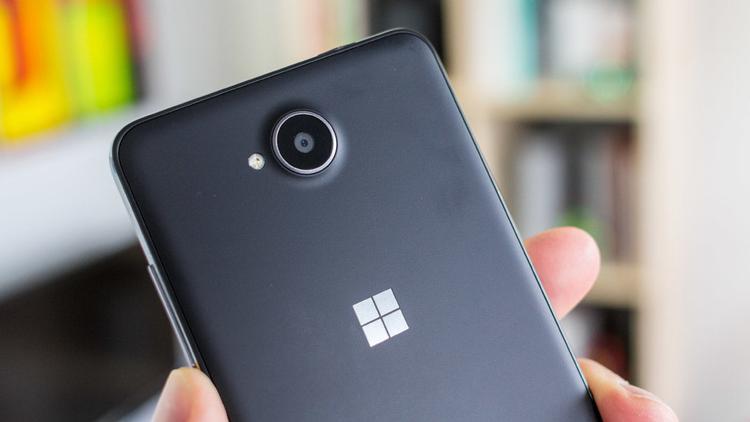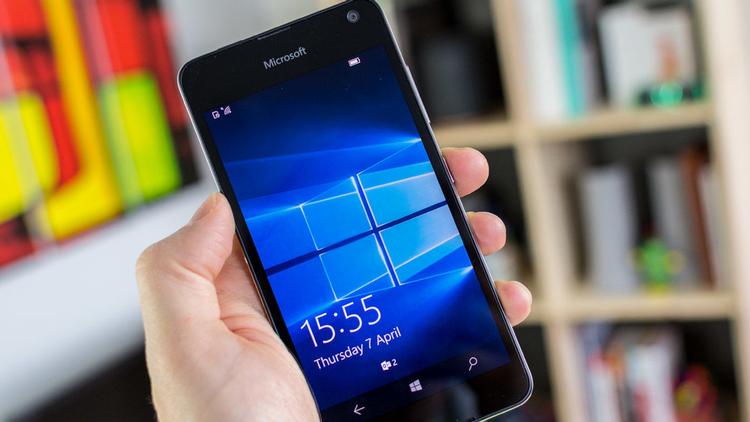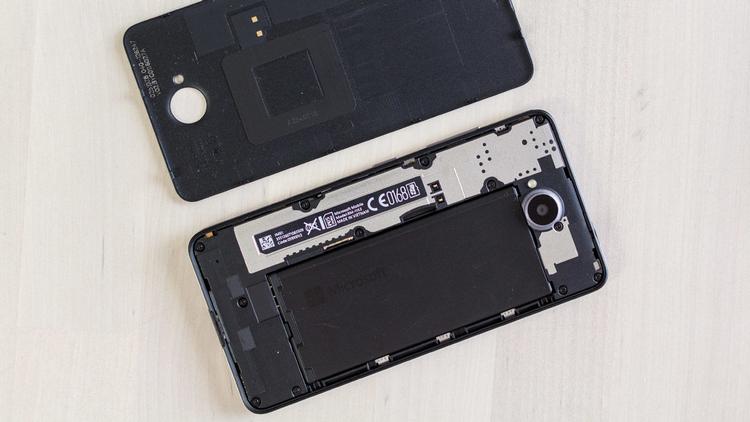Microsoft Lumia 650 review: UK price and availability – Where to buy the Microsoft Lumia 650, best Microsoft Lumia 650 deals
If you don’t want to spend £150 on a phone right now, you can also find it on contract through various mobile providers within the UK, such as EE, O2, Vodafone and iD. Read next: Best SIM-only deals. There’s a lot of competition out in the market already, such as the Moto G 4G 2015, Xiaomi Redmi 3, Cubot P12, Motorola Moto E 4G, Bluboo X9 and our current favourite, the Vodafone Smart Ultra 6. All of these phones sit at around £150 and are often found for a cheaper price. We should also mention that there are various phone cases you could purchase, such as the Krusell Malmo Folio for £24.99 and the Mozo Leather-Style Flip Cover for £19.99, among many others to personalise and protect your Lumia 650. The Lumia 650 comes with a 2 years warranty.
Microsoft Lumia 650 review: Design and build quality
The phone boasts weighs in at an impressively lightweight 122g, meaning it sits comfortably in your hands whilst having a reasonably big 5in (1280×720) screen – it also has a thickness of only 6.9mm. Unfortunately, due to having a large screen and only a HD screen, it sits quite low with its pixels density of 297ppi. This meant we were able to see text a little more pixelated over a full-HD screen or 2K display. Also see: Best MiFi 2016. Speaking of its screen, we found the overall brightness and contrast of the display to be well presented. We didn’t have any trouble using the phone in bright sunny conditions, nor at night with its brightness ramped all the way down. Despite having an OLED display, we found the Lumia 650s screen to have a yellow-tint to it. In comparison to an AMOLED screen it is thankfully less blue-toned, but versus an IPS display such as the one found in an Apple iPhone 6s, we noticed the Lumia 650’s white point wasn’t accurate. In terms of viewing angles we were happy with the Lumia 650’s display, which was able to portray a good colour reproduction at extremely off-centre angles – useful for watching movies and pictures. The phone’s display is well protected from scratches and drops by having a Corning Gorilla Glass 3 screen. However, it does attract fingerprints meaning you’ll have to clean your glass screen regularly. The overall size of the phone could have been smaller, with the bezels around the display being a little larger than we would have liked. This especially applies to the top of the phone where the top bezel is large due to the Microsoft logo being written across the top. Due to having on-screen buttons, the lower bezel might also seem a little large to some. Looking around the phone, you’ll find a Micro-USB port at the bottom, alongside a front-facing speaker. At the top of the phone you’ll find the phone speaker, proximity sensor, 5Mp front-facing camera, and a 3.5mm jack next to the phone’s microphone. On the right-hand edge of the phone there is an on/off/wake/sleep button and a volume rocker. Around the back of the phone there’s a rear-facing 8Mp camera, LED flash and a square Windows logo. The rear panel can be removed to reveal the removable 2,000 mAh, 4G LTE Nano-SIM card slot and Micro-SD card expansion slot which enables you to add a whopping 200GB of storage to your phone. We should also note that the back panel has an NFC chip on it, allowing you to quickly connect your phone to an NFC-enabled device. We should note that there is a Dual-SIM variant of the Lumia 650, which seems to be available in certain markets around the world. Also see our dual-SIM buying advice.
Microsoft Lumia 650 review: Core hardware and performance – How fast is the Microsoft Lumia 650 review?
The Lumia 650 is powered by a quad-core 1.3GHz Cortex-A7 processor which runs on Qualcomm’s Snapdragon 212. The Windows 10 Mobile phone has only 1GB RAM and an Adreno 304 GPU which is clocks up to 400MHz. We found the inclusion of the slow Snapdragon 212 chipset to be disappointing – despite Windows 10 Mobile working generally great on lower-end devices, we found the Lumia 650 to be sluggish with basic tasks, let alone heavy multi-tasking (which business users might need) or for gaming purposes. We did find the phone acceptable for very light gaming, but as soon as we ran anything intensive, then we were bottlenecked by the 212 chipset. We do not suggest comparing the phone’s specification to the specs of an Android or iOS phone, but in terms of the overall feel and responsiveness of the user interface, we felt that the phone was bottlenecked by its limited hardware. In our benchmarks, you’ll be able to see that the AnTuTu benchmark score was low and its GFX T-Rex benchmark, which was run at its 1280×720 resolution was incredibly disappointing, hitting only 5.69fps at HD, whilst its competitors such as the Xiaomi Redmi 3 (24fps at 1280×720) and Bluboo X9 (12fps at 1920×1080). On the plus side it did score better than the Cubot P12 (4fps at 1280×720), but the Cubot is a £75 smartphone, half the price of the Lumia 650 and yet was only had less than 2fps difference. Read next: What’s the fastest phone. We were unable to use Google Chrome in our browser tests and therefore used Microsoft’s Edge Browser, the default browser on all Windows 10 devices. Unfortunately, we were again disappointed by the results that the Lumia 650 was able to deliver.
The Lumia 650 comes with only 16GB internal storage which is a little conservative given smartphones these days are heavily used for photography and videos. With that said, unlike Apple’s iPhone SE which also comes with a mere 16GB storage, the Lumia 650 can be coupled with a Micro-SD card and be expanded to an additional 200GB of storage space. The fact that Microsoft has included a Micro-SD card expansion is fantastic, especially seeing as cards are extremely cheap to buy. The Lumia 650 houses a 2000mAh battery and we found it good for a day’s worth of usage. We do feel the battery life could have been slightly better, but feel that Windows 10 Mobile has several features which will allow you to improve your overall battery life.
Microsoft Lumia 650 review: Audio
Speaker quality We found the Lumia 650’s sound quality to be mids orientated, as we have found it to be the case with a lot of the Nokia and now Microsoft devices. Its speaker is located at the front of the phone, located at the bottom of the display. This makes it great for watching content on your phone as the sound is directed towards you. On our loudness tests, we scored it a healthy 7.5/10, just a little quieter than its older brother the Lumia 950 and on par with HTC’s flagship, the HTC One M9. However, due to its very lightweight construction and plastic back panel, there were slight vibrations that could be felt on the phone when used at maximum volume. Read next: Best sounding phone of 2016. Moving on to the sound quality traits, we found it to be centred around the mids and highs, with the mids being quite forward and the highs having a decent extension but could do with a better sparkle. The same couldn’t be said about the bass, where the sub-bass frequencies were non-existent and the mid-bass slam was very faint. Moving on to its soundstage, we found it to lack depth whilst having good width. The Lumia 650’s instrument separation is closed and makes the sound jumbled. Internal sound quality We weren’t expecting a great deal here, especially as we presume the Lumia 650 is utilising a SoC (system on chip) Qualcomm Snapdragon 212, with the Qualcomm Hexagon DSP which supports the impressive 24-bit/192KHz audio format. When we performed our amplifier tests, where we use a headphone amplifier to boost the internal signal to notice low-level audio signals to hear any problems a phone might possess. We found the Lumia 650 to suffer from a constant buzzing sound when on the lockscreen, whilst in the home screen there wasn’t any audible hissing, but every now and then heard small static popping sounds. The amplifier tests might be of concern to you if you use an amplifier – be it within your car or a headphone amplifier. Without an amplifier the phone was able to reproduce an average sound output at 80-85 percent volume for our ears to feel they were being filled with music. In comparison the Lumia 950 needed 75-80 percent, whilst the OnePlus 2 only needs 60-65 percent to reproduce the same output. Read our detailed breakdown of some of the best sounding phones: Best sounding phone of 2016. Listening to its sound quality, we found the lows to extend into the sub-bass regions but cut-off in the lower frequency spectrum. Its mid-bass has decent control and impact and thankfully doesn’t bleed into the mids that much. Speaking of which, we found the mids to be a little recessed creating a slightly warm sound signature. Despite being slightly pushed back we were satisfied with the forward sounding mids, producing a good all-round sound signature. The highs are a little rolled off at the top end and lack a little sparkle, but they’re not sibilant which allows you to enjoy your music for longer listening sessions. The reproduced soundstage is odd to our ears, which we presume is down to the decay, making the sound feel a little closed, lacking depth and also width. It does however have average instrument separation, but due to a slightly odd tonality doesn’t have the spacious sound that you would expect from a Microsoft phone.
Microsoft Lumia 650 review: Connectivity and extras
The Lumia 650 comes equipped with a single 4G LTE Nano-SIM slot enabling you to enjoy 4G speeds, as long as you’re on an appropriate 4G contract. Read next: Best SIM-only deals 2016 UK. The Microsoft phone comes equipped with 802.11b/g/n Wi-Fi, Bluetooth 4.1, GPS (A-GPS, GLONASS and BDS). It’s nice to see the later revision of Bluetooth included and advanced GPS tracking abilities. There is also NFC support built into the phone, a great addition for quick pairing. At this price range we didn’t expect Wi-Fi 802.11ac or a fingerprint scanner and it comes to no surprise that they’re not included at its £150 price tag. Read next: Cheapest 4G smartphones of 2016.
Microsoft Lumia 650 review: Camera performance
The phone is equipped with a rear 8Mp rear-facing camera which has an aperture of f/2.2 using a 1/4in sensor, able to take 16:9 and 4:3 pictures. The camera has the ability to record video at 1280×720@30fps which is slightly disappointing considering full-HD has become a norm within smartphones. Fortunately there is a rear LED flash for low-light shots and videos. Read next: Best Android phones 2016. Through the Camera app you’ll be able to adjust the white balance, focus, ISO, shutter speed and brightness. Useful features for taking your perfect picture. We found that taking multiple photos at once was a little hit and miss, where at times it would take several seconds before taking the photo (due to the camera looking for a focus point), whilst in other situations being able to quickly snap photos with no delay – through the camera’s settings you’ll be able to adjust the ‘Press and hold camera button’ action. The camera’s performance in low-light conditions is good, but we did find it to produce a little image noise. In bright-light conditions we were happy with the overall picture quality with no real signs of blurring or inconsistencies. However, the camera did have trouble distinguishing focus points in sunny conditions, where no matter what we tried we would get extremely dark images (without flash), due to the camera focusing on a light, rather than a the darker subject. Read next: Best phone camera 2016. The front-facing camera is also capable of 1280×720@30fps recordings and takes 5Mp pictures with an aperture of f/2.2. We found its picture quality to be good; it lacked fun selfie features which are offered by its Android and iOS competitors. The video quality of the Lumia 650 is good and performed well in our stability tests. The video was smooth and clear, whilst audio was accurately reproduced. We were again disappointed not to find full-HD recoding capabilities or 60fps abilities. Being limited to 720p is rather disappointing and this all comes from a combination of the Snapdragon 212 chipset limitations of only being able to display a 1280×720 display and the phone’s camera sensor being limited to a 720p recording. It obviously doesn’t make sense for Microsoft to have a camera recording at full-HD (1920×1080), whilst your phone’s display can only output HD (1280×720). After taking a picture the editing options are extremely limited, with you being able to only crop, automatically enhance or rotate the image. We would have liked to see more options included within the in-built photo editing tools.
Microsoft Lumia 650 review: Software
The Lumia 650 comes with Windows 10 Mobile, but lacks Continuum support meaning you won’t be able to fully enjoy desktop Windows 10 features and benefits. Through Microsoft’s website it’s clear that the ‘Lumia 650 is the smart choice for your business’, however we struggle to see it really being used by business power-users, due to the lack of Continuum support and its somewhat sluggish performance due to the crippling power of the Snapdragon 212 chipset. We did experience lag and slowness whilst switching in-between apps, especially ones which are slightly more intensive. This was a big disappointment for us, as despite not having the hardware, we were hoping for a fluid Windows 10 Mobile experience. As previously stated, we don’t expect the phone to be packed with the latest and greatest CPU, GPU nor RAM modules, but would have liked to see the Lumia 650 feel more fluid. Moving on to the software itself, we have a full detailed review of Windows 10 Mobile, which goes into the functionalities and features you can expect to get from your Lumia 650 – just remember that Continuum isn’t (currently) supported on the 650.







